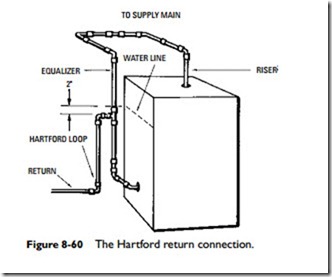Control Components
The controls used to regulate steam boilers and ensure their safe and efficient operation are similar in most respects to those used with hot-water boilers. A list of the principal controls used with steam boilers includes:
1. ASME safety valve
2. Steam pressure gauge
3. Low-water cutoff
4. Boiler water feeder
5. High-limit pressure control
6. Water gauge glass
7. Water cocks
8. Primary control (burner mounted)
9. Operating control (with tankless heater)
These and other boiler controls are described in considerable detail in Chapter 15 (“Boilers and Boiler Fittings”), Chapter 4 of Volume 2 (“Thermostats and Humidistats”), and Chapter 9 of Volume 2 (“Valves and Valve Installation”).
Hartford Return Connection
A well-designed steam heating system will have a Hartford return connection (Figure 8-60) in the condensate return line. The purpose of the Hartford return connection (or Hartford loop, as it is sometimes called) is to prevent excessive loss of water for the boiler when a breakdown (such as a water leak) occurs in the return line.
As shown in Figure 8-60, an equalizer connects the lower outlet to the steam outlet. The Hartford connection is taken off from the equalizer an inch or two below the normal water level. Evidently low pressure can only draw water out of the boiler connection. This gives a low water level, and it cannot recede further because steam will flow into the connection leg as the water recedes in the leg due to pressure difference.
More details about different boiler connections are found in Chapter 15, “Steam and Hot Water Space Heating Boilers,” and in Chapter 9, “Valves and Valve Installations” in Volume 2.
